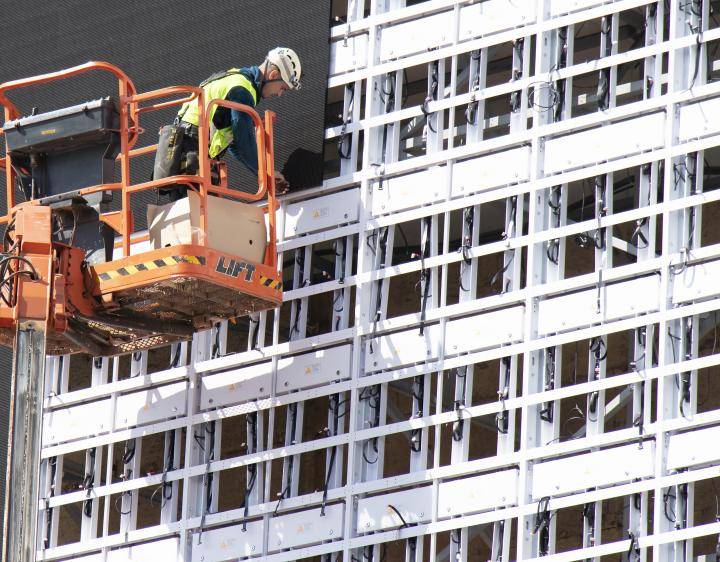
This article appears in our Q2 2019 Quarterly Report.1
Buildings are a big deal for climate change. The International Energy Agency (IEA) thinks they are responsible for up to 40% of global emissions. That number includes both the construction and use of buildings.
The situation may get worse before it gets better. The pace of global urbanisation is staggering. The IEA forecasts that we will add 230 billion square metres of new construction in the next 40 years. That’s the same as adding a whole new Paris every week.
Negative environmental impacts
This is bad news from a biodiversity standpoint. It creates real water conservation challenges. It is also an energy problem because buildings still have some way to go in efficiency terms. The IEA’s data shows that total energy intensity in buildings fell 25% between 2000 and 2017. This wasn’t enough to prevent an increase in overall energy use of 22%. And it was due to quite different outcomes for different parts of the building value chain.
Success stories
The standout building efficiency success story is lighting. Light-emitting diodes (LEDs) increased achievable energy efficiency roughly ten-fold. Where a standard incandescent bulb is capable of 13 lumens of light per watt of power, a LED can provide around 120. Driven by this performance, LEDs grew from 5% of the lighting market in 2013 to 40% in 2018.
But this success contrasts with the other components of building efficiency. Heating systems, cooling systems and appliances have recorded some efficiency gains. But these haven’t been fast enough. The improvement pathway for them is more incremental. And so it is, for the building sector as a whole.
We can contrast this with the power generation and transport sectors, which are also big carbon emitters. In both, there are game-changing technologies already in view. Renewables and electric vehicles are already viable. It is now a question of adoption, and bending the cost curve downwards.
For buildings, there is more to do. The pace of innovation needs to increase. But there is also a bigger role for regulation.
Environmental regulation
By definition, energy efficiency improvements save money. But those savings come when the building is used. The original builder won’t necessarily benefit. Buyers of buildings are thinking about all kinds of factors, and energy cost is just one of them. So there may not be the right incentives to install the most efficient equipment.
That’s where regulation and building standards come in. Efficiency standards compel builders to construct better buildings. There has been a rising tide of these regulations. The IEA estimates that there are now regulations covering 40% of global energy consumption from buildings. That’s increased from under 20% in 2000. The rate of increase shows some sign of slowing at the moment. But it is important that it doesn’t slow down yet.
At WHEB we don’t like headline policy risk when we invest, and we try to avoid uncertain subsidy regimes. But a gently rising tide of tightening regulation can be attractive. It creates a barrier to new entrants. It also allows companies to compete based on the quality of their products. And it encourages innovation.
Efficiency as a competitive advantage
The companies we invest in within the building value chain understand the importance of efficiency. They use it as a competitive differentiator.
AO Smith makes the most efficient water heaters in its markets around the world. Daikin benefits from superior efficiency in at least three product areas. Its air conditioning units are ahead of the competition, especially in developing countries. Its ground- and air- source heat pumps lead the way in space heating. Daikin also supplies refrigerants with a much lower global warming potential than its rivals.
The same is true for Kingspan in insulation, and Johnson Controls in building controls and safety. When Acuity Brands led the way in the widespread adoption of LEDs, the efficiency improvements were way ahead of any regulatory requirements. Acuity is now turning its attention to improving building efficiency through digital controls.
Construction of course has its own cycle and is linked closely to macroeconomic developments. But across the cycle, sustainability is driving the steady adoption of more resource efficient building solutions. The pace of change needs to increase, and we aim to be positioned to benefit.
